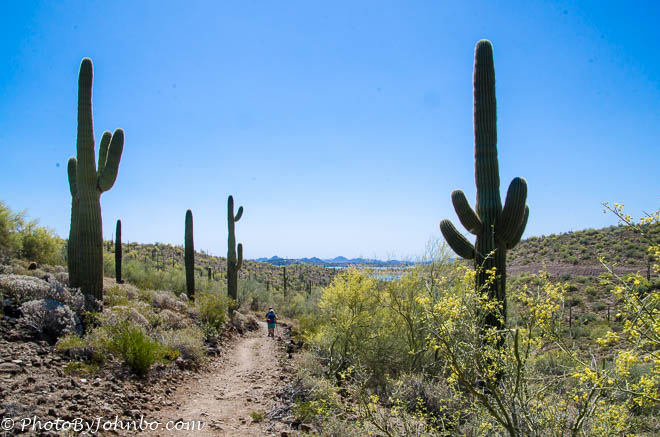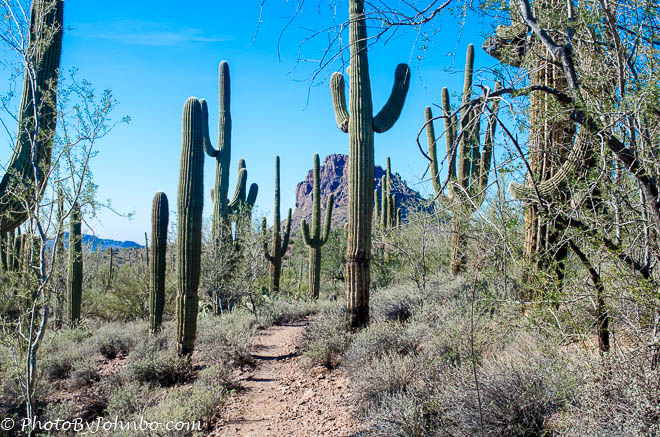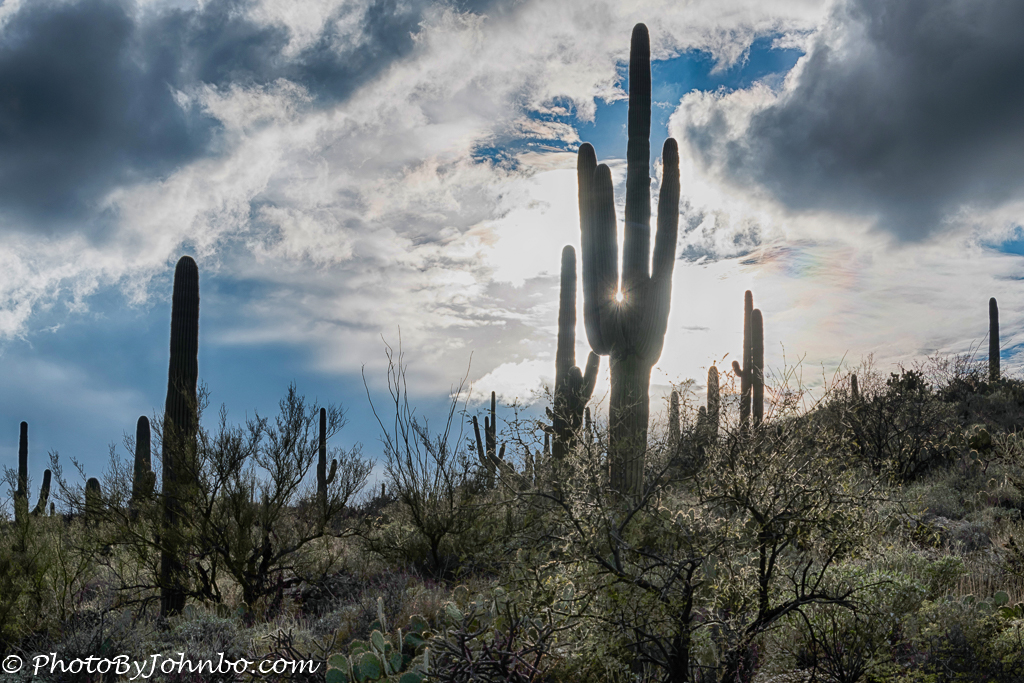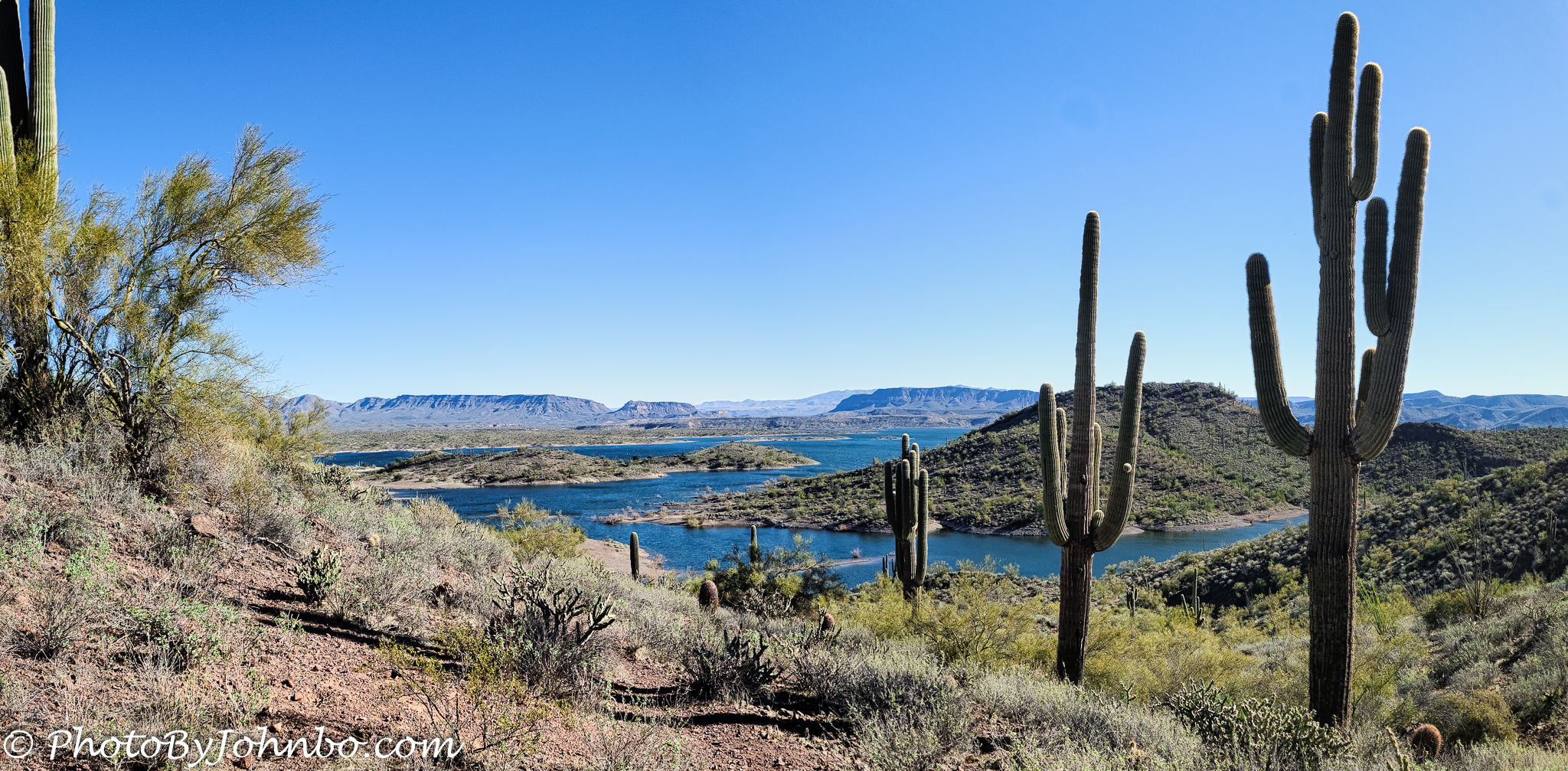Buckeye, Arizona.
This week, scillagrace guest-hosts the weekly photo challenge. She writes, “My invitation to you is to present a “Getting To Know You” post showing your relationship with a subject you’ve photographed. The subject could be a Person, a Place, a Culture, an Object…anything that has captured your attention, won your affection and taught you a thing or two.” You can read her entire challenge post here.
Almost a decade ago, my wife and I made a decision that changed our lives. We decided to spend our winters in Arizona. With that decision, it didn’t take long for me to realize that I could forget almost everything I thought I knew about “the desert.”
There is so much about the desert that I have learned, but instead, I will focus upon a single desert plant that lives only in the Sonoran Desert, the Saguaro Cactus. Two of those giant succulents are shown in the opening image with my wife included in the image to provide you, dear reader, with a size reference.
The saguaro’s home in the world is southern Arizona, northwestern Mexico, and extreme eastern California. It only survives in the Sonoran Desert because the Sonoran is the wettest desert in the world. You see, saguaros need lots of water to survive their typically 200-year lifespan. Indeed, those “arms” seldom show up before a specimen’s 70th year.
Saguaros proliferate when birds defecate the undigested seeds gathered in their travels. The seeds, often “planted” near or under trees and bushes, germinate and the shade of the tree or bush protects the young cactus from the intense Arizona summer sun.
Once the saguaro grows tall enough to survive on its own, the plant’s demand for water grows and the precious liquid is “stolen” from the tree or bush that gave it life in the first place. Eventually, like in the image above, the tree begins to die for lack of water as the saguaro grows healthy and stores excess water for its needs in its internal structure.
Saguaro forests are common in the Sonoran Desert. I always marvel at traveling north on I-17 between Phoenix and Flagstaff. As we climb out of the desert, those saguaro forests simply disappear as the terrain climbs higher than the saguaro can handle.
Near Tucson Arizona, Saguaro National Park is dedicated to the magnificent saguaro. The park is divided into two units, the west unit is west of the city and the east unit is east of Tucson.
At Lake Pleasant, this row of saguaros guides the hiker along the Yavapai Point Trail. I conclude this post with a shortlist of other things I’ve learned about the mighty Saguaro.
- It can take 10 years for a saguaro to grow its first inch (2.54 cm) in height.
- Mature saguaro can grow to more than 40 feet (13 m) tall.
- An adult saguaro is considered to be about 125 years of age.
- A mature saguaro can store 1,500 gallons (5,678 L) of water.
- Saguaro roots are seldom deeper than 5 inches (13 cm) but they extend outward as far as the plant is tall.
Thanks again to scillagrace for allowing me to share what I learned about Arizona’s iconic saguaro cactus.
John Steiner







Thank you for sharing that very interesting Saguaro information. Lots of things I did not know.
The saguaro is an interesting plant species to me.
Thanks for all the information on the saguaro cactus. It was fascinating and interesting.
Glad you enjoyed the post. We just turned onto I29 at Sioux Falls about 20 minutes ago. Home today around 4:30 or so.
Thanks for joining the challenge, John, and teaching me about the majestic saguaro. I really haven’t seen them “in the wild” before and didn’t know there was a National Park dedicated to them. I must put that on my list! Your photos are beautiful, especially the one with the cloudy sky and sunburst through the saguaro’s branch. Stunning!
That saguaro sunburst was photographed at Saguaro National Park. Thanks for the compliment!
What a great post John! I loved your factoids at the end since I’ve enjoyed the saguaro in my many visits to my brother’s home in AZ but never knew the details of it”s lifespan. Ten years to grow an inch?!??! 1500 gallons of water?!?!?! Wowza. As always, wonderful images to illustrate your points.
Thanks for the compliment. Ever since seeing this majestic cactus in the desert, I am more impressed than when I saw them in the old west movies. 🙂
Impressive, interesting and rather fantastic – nature is! Thank you for the facts and the stunning photos. Now I will be very attentive next time I see a western movie too…
I always enjoy when they get saguaro on location, but the story locale isn’t a place where saguaro are found. >grin<
🙂
The saguaros make such striking silhouettes – you have captured the wonder of walking among them…
They are icons of the American southwest. Thank you for the follow!
Great post. The mighty Saguaro. I’ve heard a person is subject to hefty fines or even jail time if they damage or remove one.
Except on one’s own property, I understand.
They really are fantastic. Certainly nothing like them here in Canada.
Unique in all the world for sure.
Very nice pictures and incredible facts about cacti!
Thanks. The saguaro is an interesting and unusual species, for sure.